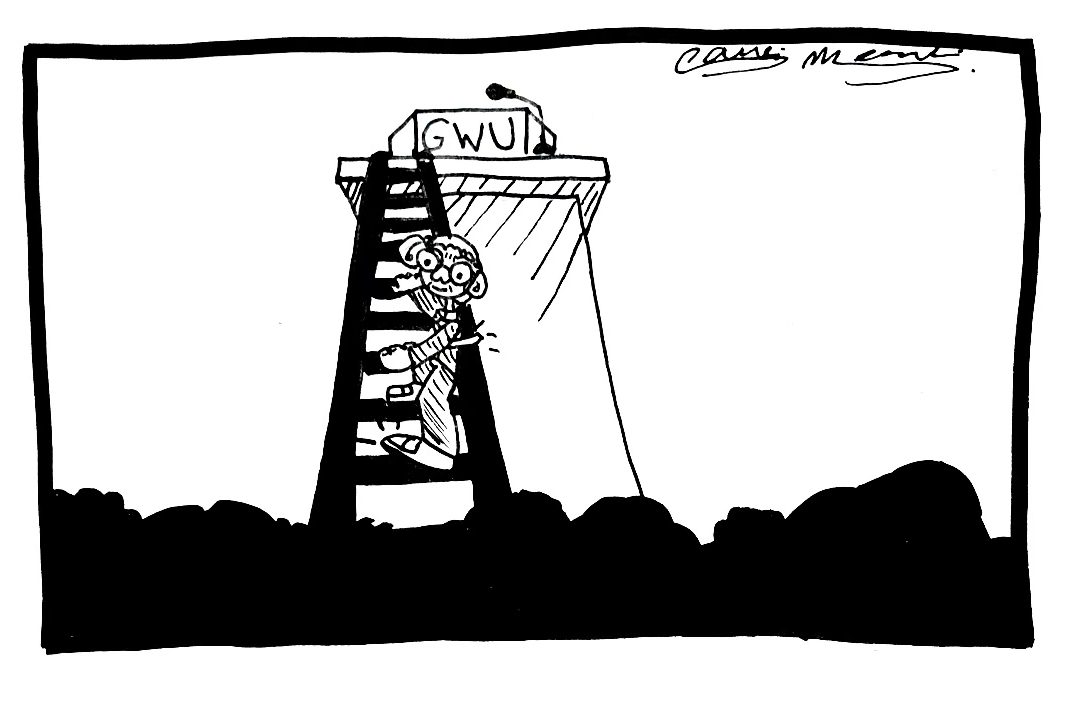Harald Griesshammer is an associate professor of physics. He sits on no committees and is on sabbatical in academic year 2019-20.
University President Thomas LeBlanc likes to close meetings with thought-provoking big-picture ideas. In an email just after GW left town for the summer, he proposed to both reduce GW’s undergraduate population by 20 percent and grow the number of science, technology, engineering and mathematics majors. The Board of Trustees appeared sufficiently enchanted to approve this.
The reporting phase of LeBlanc’s five strategic initiatives detailed where GW’s student and research culture must change. But in academia, we review pros and cons, and then plan before acting. End-of-meeting brainstorming and website feedback are a good start but cannot replace that. Catch-phrases that LeBlanc uses like “right-sizing” and “better, not bigger” do not justify “smaller.”
In shared governance, academic decisions must follow meaningful consultation of the elected faculty representatives in the Faculty Senate and committees. They have not spoken yet. In matters as fundamental as this one, their expert advice is near-binding and can be overruled only in rare circumstances. As the change would affect present and future students quite a bit, the Student Association has a say, too. Besides the formal argument for consultation, one should remember that a broad consensus of those who actually live the change is imperative for its success. So let us talk about intended and unintended consequences of both the reduction and STEM growth.
If admissions decrease, GW will at first appear more selective and thus rise spectacularly in some university rankings. But as prospective students adjust to what would be GW’s new normal admissions policy, it will resume its original place within a few years. How can a more selective GW continue to become more diverse and inclusive, given the strong correlation of test scores, ethnicity and parent income?
What could students see, besides 2,400 fewer peers? Possibly shorter queues and improved services, if that budget is not cut commensurately. But the change does not solve GW’s systemic bureaucratic excess and turf wars. Those might actually increase as the fight for pieces of a smaller pie heats up. More STEM means more than 20 percent reductions in non-STEM, some of which are GW’s strengths. Who will pick winners and losers? For undergraduates, the position of the Columbian College of Arts and Sciences will be crucial since it teaches the liberal arts curriculum for all and hosts half of GW’s majors, plus all science and math. But for undisclosed reasons, the search for its dean is on hold, unlike other searches. As CCAS faculty is quite vocal and enthusiastically backs its interim dean, it is hopefully not marginalized. Likewise, will the next provost, hired to execute the idea, be comfortable to provide candid advice or partake in an echo chamber?
Losing 2,400 students means losing up to $100 million in revenue – or 10 percent. So how do we improve the student experience, make GW a true research university and balance the budget at the same time? Certainly not by fewer student services, fewer tenure-line faculty, less research, more teaching outsourced to adjuncts, larger classes or more debt. Higher net tuition would reinforce the very image as a school for the wealthy that we want to shed. Maybe the market allows for more master’s students, but that should be studied carefully. And how would GW change when graduates outnumber undergraduates?
Populists talk up savings from “administrative waste,” “synergies” and “centralization.” But GW’s central units just suffered years of 5 percent cuts, which are largely responsible for substandard services. With a host of activities triggered by the culture initiative’s findings, GW implies its struggle to recruit and retain competent staff, overworked and underpaid as they are. That costs money. It is hard to see how further cuts will help. GW is finally decentralizing, meaning it puts service close to need. That is not just good corporate practice, it strengthens the bond between faculty, staff and students. Two examples: That research awards are now administered by schools re-invigorated the Office for Research; and CCAS’s Office of Technology Services unit serves many student and faculty needs, which the central Division of Information Technology can or will not. We need more such smart decentralization, not central power-grabs.
As GW aspires to “be a preeminent comprehensive global research university” and U.S. higher education is too expensive and too elitist, LeBlanc’s bold idea is worth close examination. There are no simple answers. We need to combine remedies. Let us discuss its feasibility and consequences with all deliberate haste to find the right mix. Let us weigh pros and cons before rushing to action. Let decisions be informed by facts and likely outcomes. Change of this magnitude needs not just strong but passionate support by staff, students and faculty. In this crucial time, let your voice be heard, let your expertise have an impact. Let us not shoot first and ask questions later.



